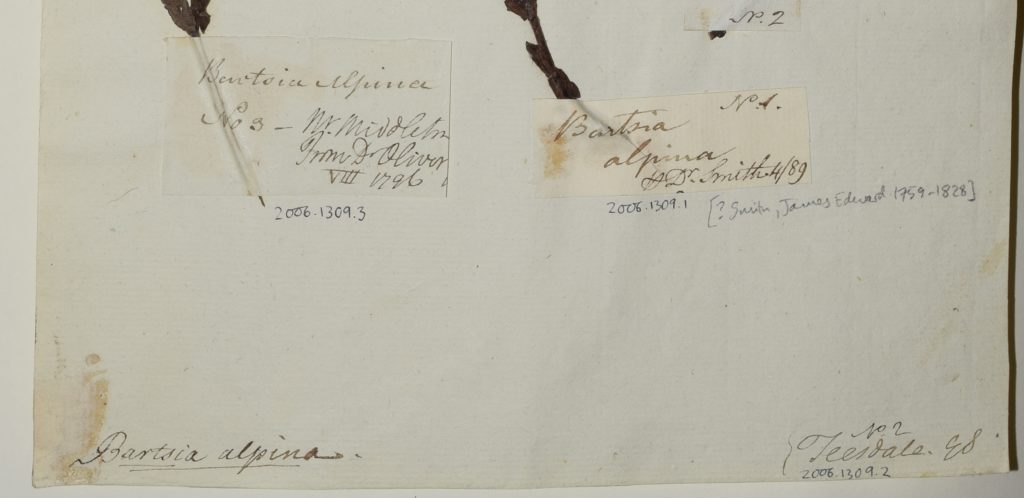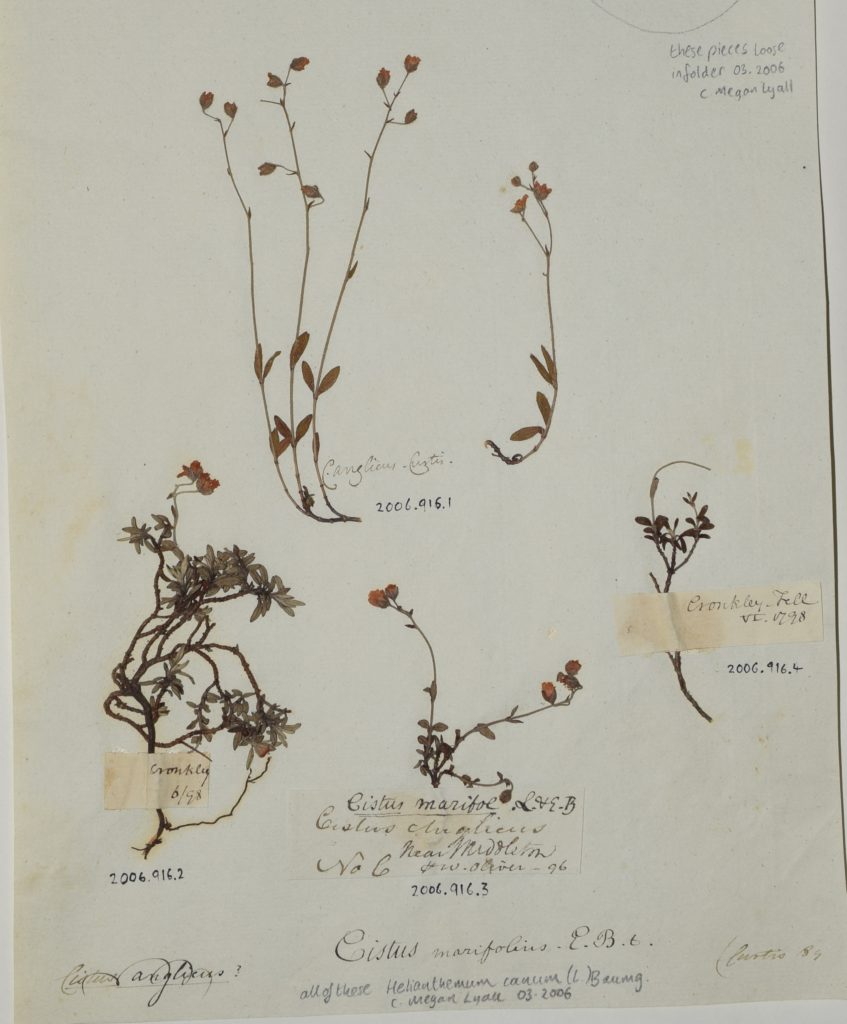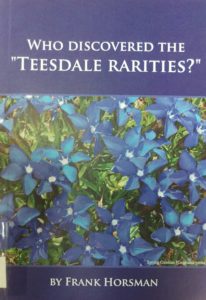by Frank Horsman
A number of botanists have been overlooked in the botanical recognition of Upper Teesdale. My aim is to put this right.
The unrecognised botanical pioneer of Upper Teesdale was Rev. Ralph Johnson (1629-1695) of Brignall in (lower) Teesdale, a friend of John Ray (1627-1705), the greatest English naturalist of his day, who visited Johnson at his home in Teesdale with Thomas Willisel (d. 1675?) in 1671. Johnson pointed out the shrubby cinquefoil to Ray which Johnson had discovered, new to science. Johnson also found the dwarf birch and the Scottish asphodel on Widdy Bank in Upper Teesdale.
Christopher Hunter (bap.1675-d.1757) of County Durham is recognised as an antiquarian but is totally unrecognised as a botanist. He was an associate of Johnson’s who botanised in Upper Teesdale.

Label from Edward Robson’s herbarium at Sunderland Museum. TWCMS : 2006.1309 Bartsia alpina
There followed an interregnum in the cultural climate in England which resulted in no botanising being done in Upper Teesdale until the arrival of William Oliver (1761-1816) from Hawick in the Scottish Borders in 1783. Oliver was a surgeon/botanist whose job as a surgeon took him around Upper Teesdale on call. He, too, has been overlooked as a botanist. His botanising in Upper Teesdale was not known about until Rev. John Harriman (1760-1832) arrived in Eggleston in 1795/96. Harriman, best known as an unfulfilled lichenologist, knew Edward Robson (1763-1813), a Quaker botanist of Darlington. Edward was in touch with the botanical literati of the day, principally in the persons of James Sowerby (1757-1822) and James Edward Smith (1759-1828). Sowerby engraved the pictures and Smith wrote the letterpress for the classic English Botany (1790-1814) which features heavily in this story.
Oliver was discovering “Teesdale rarities” in Upper Teesdale in the period from after 1783 until he combined forces with Harriman in 1796. Harriman sent specimens of Oliver’s finds to Edward Robson who sent them to Sowerby. From 1796 onwards the discoveries were made essentially jointly by Oliver and Harriman, with the assistance of John Binks (1766-1817) a lead miner of Middleton-in-Teesdale who collected simples for Oliver in the course of which Binks discovered many of the “Teesdale rarities”. Binks is still under enquiry with me. In that he was a bachelor and an itinerant lead miner, this is proving difficult. However, the often repeated statement that he discovered some or all of the “Teesdale rarities” in Upper Teesdale is an exaggeration.
Botanising in Upper Teesdale stopped again with the departure of Harriman in early 1801. Harriman’s key role was as a link between Oliver and Robson for the “Teesdale rarities”. Had Harriman not moved from Barnard Castle to Eggleston in 1796, Oliver and Binks’ botanical discoveries and the subsequent botanical recognition of Upper Teesdale would have been delayed for a number of years. The botanical activities of Oliver, Binks, Robson and Harriman in Upper Teesdale were effectively announced in the pages of English Botany which contributed to the botanical recognition of Upper Teesdale and led botanists to start visiting Upper Teesdale. Smith always credited the finder of a particular plant. James Dickson (1738-1822), the renowned cryptogamist, visited in 1799 and discovered the false sedge and broad-leaved cotton grass.
William Brunton (1775-1806), another Quaker botanist from Ripon in North Yorkshire, visited in 1800 and contributed to working out the taxonomy of the false sedge.
Nathaniel J. Winch visited in 1799, 1800, 1801 and 1802. He co-edited The botanist’s guide through the counties of Northumberland and Durham of which volume one, 1805, certainly achieved the botanical recognition of Upper Teesdale. Any botanist picking up this book could not fail to recognise the botanical richness of Upper Teesdale.

Label from Edward Robson’s herbarium at Sunderland Museum. TWCMS : 2006.916 Helianthemum canum
That outside botanists started to visit from 1799 is accounted for by Edward Robson circulating his printed Plantae rariores agro Dunelmensi indigenae (rare native plants of County Durham) which is dated 1 May, 1798, and already includes a significant number of “Teesdale rarities” including spring gentian, alpine bartsia, Scottish asphodel and mountain avens. Amongst the botanists now visiting Upper Teesdale, the Backhouses, James Snr. and James Jnr., became synonymous with the flora of Teesdale. James Snr. visited in 1810 and 1811 when he was only about seventeen years old and was shown the “Teesdale rarities” by John Binks. The Backhouses were to make their own botanical discoveries in Teesdale and their Herbarium is now held here at RBGE.
Dr. Frank Horsman FLS
Images used with permission from Tyne and Wear Archives and Museums
Please note: the book: “Who discovered the “Teesdale rarities?” ” by Dr Horsman is available from the Author at 10 Park Avenue, Leeds LS8 2JH. Cost £19 + postage.

